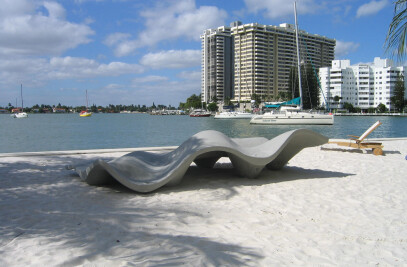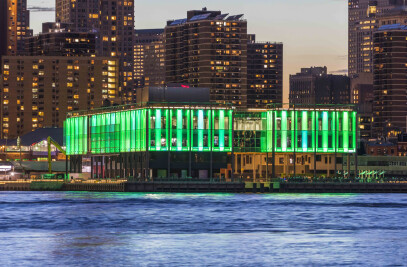From a public landfill in the mid-1800s to a world-class public park in a Midwestern city of 100,000, South Bend, Indiana’s Howard Park has become the city’s marquee park property. The park has undergone several iterations since its opening in 1899, but for the last several decades had fallen into disrepair. The ice rink had long been shut down, and the park grounds and community center were aging and underused.
That all changed in November of 2019 when the community celebrated Howard Park’s transformation.
Just three years prior to the park’s opening, The City of South Bend began work on the park’s redevelopment. City leaders enlisted input from the community and stakeholders from which a master plan was developed. South Bend-based Alliance Architects was selected to design the park, and then it was off and running. Alliance Architects’ Bill Lamie, AIA, the principal leading the project, proudly notes the challenging 14-month construction schedule that was successfully met.
The 13-acre park fulfills four guiding principles identified by city leaders. The renovations had to demonstrate good stewardship of the community’s funds through operational efficiencies and a sustainable funding model. Second, the design had to be ecologically sound, using nature as a model. Third, the park had to be inclusive. Aaron Perri, executive director of South Bend Venues, Parks, and Arts, refers to Howard Park as “everybody’s party.” And finally, the park had to surprise and delight. “We wanted to ensure that people would keep returning to Howard Park, that the design and park elements would create a sense of wonder and discovery and Instagram moments,” says Perri.
Lamie and Landscape Architect Kevin Clark of The Lakota Group, who collaborated with Alliance Architects, describe how their design reflects the park’s guiding principles.
Municipal projects typically adhere to a strict budget, and Howard Park was no different, says Lamie. “We made compromises on some design elements but stuck with those that truly created a state-of-the-art experience for visitors. The entrance to the playground, the ice pond and trail, the rolling landscape, and organic trails all contribute to that memorable experience. Our city partners felt the same way. We prioritized and created a beautiful public space.”
Howard Park is on track to become the area’s first LEED v4-certified public park and incorporates ecological design and material choices throughout. “The park runs along the St. Joseph River, so our concept builds from the idea of a flowing river,” says Clark. “The landscape has movement with grade changes and winding trails. The blue and green palette, stone buildings and outcroppings, and sculptural site elements create an organic feel.” Lamie adds: “LEED certification became a major part of our program. It was the right approach for South Bend’s first urban downtown park. It is a recognizable achievement and nice message to the community and visitors.”
Howard Park is an inclusive park, with universal access throughout and an ADA-compliant community center. “We designed a place for everybody,” says Clark. “Equitable, multigenerational, and for people of all abilities and socioeconomic status.” The park’s contemporary outdoor features and Community Center were designed with flexibility in mind for large and small, formal and informal events year-round. The park also includes new contemporary architecture programmed to host a variety of events.
Surprise and delight are in no short supply at Howard Park. “Attendance figures shattered what we could have imagined,” says Perri. “The park hosted 150,000 visitors in a town of 100,000 when it was fully opened in the winter of 2019.”
The centerpiece of Howard Park may be the playground, ice pond, and ice trail. “The master plan was to bring back ice skating to the park in a new way,” says Lamie. “Instead of a large ice rink, we designed an interesting ice trail that contains the playground area. People enter the playground under the bridge that features rotating colored lights. The forms, colors, and landscaping that buffer the ice trail and playground become sculptural elements that blend together.”
Architecture and engineering firm Stantec’s ice, fountain, and lighting designers created the park’s refrigerated skating trail, skating bridge, and interactive water, ice trail, and plaza lighting features. “Our work with Bill Lamie created a four-season park that works as well in the winter as it does in the summer,” says Stantec’s ice and fountain engineer Jim Maland. The refrigerated bridge, which Maland believes may be the only one of its kind in the country, creates a continuous skating loop and also gives families a ground-level entrance under the bridge to the playground in the center of the ice trail, allowing both areas to function safely throughout the winter.
The 15-foot-wide and 650-foot-long trail offers skaters a new and dynamic skating experience. “The trail’s contours and slopes give beginners and skilled skaters and people of all ages a unique recreational experience,” says Maland.
The ice design team also established heat recovery, control systems, and the use of a natural refrigerant (ammonia) for the park’s refrigeration plant that helped achieve the park’s LEED certification. But the idea of an ice trail as opposed to an ice rink in and of itself adds a level of sustainability. Maland explains: “With an ice rink, you have most people skating around the perimeter and a few advanced skaters in the middle of the rink. There is a lot of empty and wasted ice, which equates to wasted energy. The ice trail is a more sustainable and efficient approach for refrigerating outdoor ice and saving some energy.”
A water and lighting feature gives the plaza area the excitement and energy Lamie and Perri wanted for the Howard Park visitor experience. The programmable light and water feature is both “aesthetic and interactive,” says Stantec’s lighting consultant Mike Fitzpatrick. “It creates different water patterns and colors that suit different daytime and nighttime park activities. And it’s a year-round feature that uses custom designed globes to display interactive lighting in the winter and, when removed, light and water features in the warmer seasons.”
The design of the Landscape Forms lighting and site furnishings selected reinforces the organic, sculptural characteristics of Howard Park’s buildings, hardscape, and greenscape.
The design team selected FGP area lights and Torres area, wall-mounted, and catenary lights for their contemporary aesthetic, which Clark describes as “timeless and interesting.” The FGP area lights are located along the perimeter of the park, pathways, and ice trail. The Torres lighting creates an intimate, pedestrian-scale ambiance setting in the plaza area. Staggered and back-to-back Torres fixtures on single poles allowed the designers to use fewer poles, decluttering the landscape. And the family of Torres fixtures gave Clark the ability to aesthetically link elements from taller area lights with single and double fixtures around the ice pond to the smaller scale wall-mounted fixtures on the community center and other buildings.
“Torres lights contribute to the sculptural aspect of the park,” says Clark. “They reinforce the other amenities and the organic shapes.” Lamie agrees, noting that the Torres lighting “blends beautifully with the more formal design of the plaza.” A Torres catenary prominently lights the bridge and tunnel entrance to the playground. “Lights are an important element to any site, even in the daytime,” says Clark. “They link things together. They create a visual experience at night, but they also unify shapes and define pathways.”
Safety is essential to lighting a public park, and the park’s light levels and lighting design offer visitors the visibility and comfort they need while meeting the city and project’s environmental goals. “Our city standards stipulate warm 3000K color for all lighting,” says Perri, “and the products we selected honor Dark Sky philosophy.”
The plaza area features Escofet’s Twig and Lungo Mare benches. “Escofet benches are sculptural elements. We placed them in key locations because they are focal points,” says Clark. “Visitors comment on the sculptural nature of Lungo Mare seating and Twig benches,” says Lamie. “They reinforce and complement the consistency of Howard Park’s design.” FGP backed and backless benches in two sizes and Stop Bollards are also located in the plaza area. “All of the site elements work well together, and that’s the strength of the final result,” says Lamie.
Howard Park may be South’s Bend marquee park, explains Perri, but the city has embarked on a large parks improvement project, and the Landscape Forms site elements and lighting selected for Howard Park will now be the standard for new and renovated parks in South Bend. “We’ll continue to use Landscape Forms products to create visual consistency in the parks along the river,” says Perri. “Community response to Howard Park has been incredible,” he continues. “Open space is now as important as it has ever been, and Howard Park is giving the community a great space to enjoy the outdoors.”









































